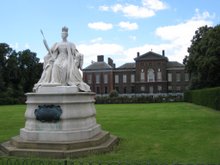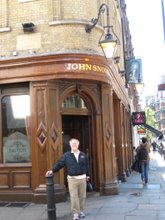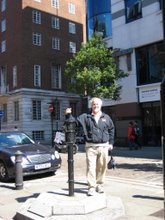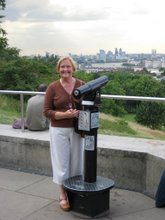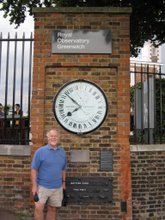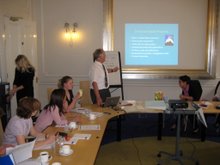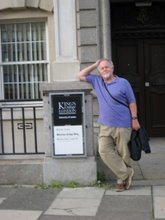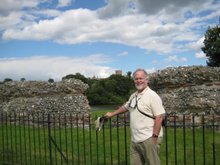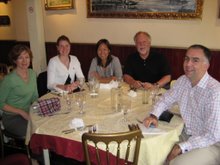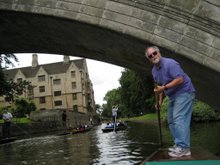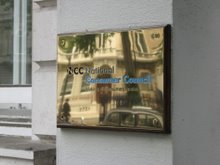Welcome to London and to the Kings College (London) and the National Social Marketing Centre. I am trying out this blog as a way of sharing my experiences while in London (and elsewhere in the UK and Ireland) in conjunction with a Fulbright Senior Specialist Award I received this summer. This is my first journey into "blogging"; so please forgive my clumsiness with the technology and the fact that it is a lot harder to keep up with the daily entry than I ever thought. So this is a "sort-of" daily blog, but the intervals got longer as the time went by. Also, please note my disclaimer--taking all responsibility for the informal entries and observations. Enjoy!!!
Note! The blog starts at the end and goes to the beginning (July 2, 2007). Also make sure that you check on the "older postings" at the bottom to get the earliest material.
Wednesday 17 October 2007
Friday 10 August 2007
Last Day - US National Strategy for Social Marketing
August 10, 2007
Day 42 --Last Day
It is my last day at the National Social Marketing Centre (NCSM) and this phase of the Fulbright Senior Specialist Program. Tomorrow, Linda and I head for Ireland and a week of exploring the southern and western coast before going home to the USA.
I hope that this blog clearly tells the story of our wonderful and, for me at least, life-changing experience here in London. Seldom does someone in my position at a small, state health department, have the chance to observe—even participate—in public health operate on a national—or even global scale. It is a humbling and awe-inspiring experience. A great big "thank you" to all our new friends at NSMC, Kings College and others places in London and England!
As I mentioned in an earlier segment of this record, the experience leads me to consider a national strategy for the development of social marketing in the US. The argument goes something like this….using obesity as an example.
According to the English Department of Health document on the Healthy Living Social Marketing Initiative (2006) “the prevalence of obesity in the UK, in common with countries across the world, continues to rise. If present trends continue, 33% of men and 28% of women will be obese by 2010. The rate of increase in obesity among children and young people is very similar to that of adults, rising from 9.6% to 14.9% in boys and 10.3% to 12.5% in girls up to the age of 11 years in 1995 and 2003 respectively, and predicted to be 17% and 19% respectively by 2010. Given that weight is frequently gained throughout adult life, there is a legitimate concern that the prevalence of obesity is set to escalate further. Moreover, the magnitude and duration of excess weight are strongly associated with the burden of related ill- health. Accordingly, childhood obesity is sometimes referred to as ‘a ticking time-bomb’ of disease.”
It goes on to say that “the ‘Healthy Living’ Social Marketing Initiative provides a framework to deliver a concerted national programme of work that drives deep-rooted shifts in cultural values and social norms. A key aim must be to reduce the negative impact of the ‘obesogenic’ environment and instead create a positive climate that supports and facilitates the necessary changes in the diet and activity habits of parents and their children to achieve and maintain a healthy weight. We must reduce the impact of the ‘obesogenic’ environment and create a positive climate for change….. through collective working towards the common goal of improved health and well-being for the population at large and children in particular.” (emphasis mine).
In the US, the prevalence of overweight and obesity has increased sharply for both adults and children since the mid-seventies. Data from two NHANES surveys show that among adults aged 20–74 years the prevalence of obesity increased from 15.0% (in the 1976–1980 survey) to 32.9% (in the 2003–2004 survey). The two surveys also show increases in overweight among children and teens. For children aged 2–5 years, the prevalence of overweight increased from 5.0% to 13.9%; for those aged 6–11 years, prevalence increased from 6.5% to 18.8%; and for those aged 12–19 years, prevalence increased from 5.0% to 17.4%. These increasing rates raise concern because of their implications for Americans’ health and because in spite of current efforts, that the situation is worsening rather than improving. (Source: http://www.cdc.gov/nccdphp/dnpa/obesity/)
Unlike the English experience, the US does not have a unified national strategy for the development of social marketing to support a “collective working towards the common goal of improved health and well-being for the population.” Given the evidence amassed by the NSMC and others in support of the effectiveness of social marketing to improve the behavioral outcomes of public health programs, I believe that a national strategy is not only possible, it is essential to a sustained contribution of social marketing to improved US health objectives.
Rev 8/7/07
DRAFT
Framework for an American National Strategy for Social Marketing (for developing the social marketing community (in public health?)*
Introduction:
The independent review of the first English national review of social marketing (It’s Our Health, 2006 http://www.nsms.org.uk/images/CoreFiles/itsourhealth.pdf) found that the adoption of social marketing in a systematic way will increase the impact and effectiveness of health-related programs and campaigns at the national level. It also concluded that current approaches were unlikely to deliver policy goals or provide sufficient leadership and coordination; that social marketing could use resources more effectively, but was underdeveloped and required research and evaluation to maximize its value.
This is not the first acknowledgement of the potential contribution of social marketing on a grand scale. Indeed, both the US Agency for International Development (USAID) http://www.psp-one.com/content/resource/detail/4070/ and the English Department for International Development (DFID) http://www.dfidhealthrc.org/publications/srh.html
promote the extensive research and practice of social marketing programs around the world. There are, of course, many other examples both from home and abroad.
The English experience, in particular, raises an interesting question about the need for a national strategy to promote social marketing in the US. How could the field move forward to link together the resources and networks and develop a capacity to mobilize and sustain the potential of social marketing to increase the impact and effectiveness of health-related programs and campaigns at the national level in the US? The purpose of this paper is to present a draft framework for further discussion of this strategy, at least for public health, extending if possible to its possible final form and process for achievement.
The US Social Marketing “Community”
First, it may be useful the think of social marketing as a “community” in the US, as opposed to a single profession, discipline, field or other line of work. Community has at least two elements that are useful for this purpose. First, community connotes individual, groups and institutions interacting with one another rather than just a population defined organizationally, demographically or geo-politically. So the social marketing community has training, research and practice components and includes various kinds and levels or organizations (governmental, private, academic, professional, etc.) Second, these interactions are based on common interests, both general and specific, rather than on a scope of professional knowledge or practice. In other words, the community may include those interested in public health as well as those interested in environmental sustainability, public administration, education or other areas of “social good.” It is well-known that social marketing includes more than just public health, but there may be less recognition that to be successful in establishing a national strategy, social marketing in public health will have to involve partners in different professionals, contexts and primary interests.
So planning is about the entire community, not only public health or universities or government agencies…an important, albeit challenging starting place.
The American Value Context:
The US faces a unique opportunity to create and achieve a strategic plan for social marketing. The English experience indicates that there is somewhat of an aversion to the term “marketing” in that society. In America, the aversion is more about the term “social”—giving rise to visions of increasing taxes, more government, run-amok welfare and even an American version of the “nanny state.” This is less applicable, of course, among those who envision government and institutions as vehicles for social improvement and change—such as many in public health and other similarly disposed fields.
Fortunately for strategic purposes at least, “marketing” resonates with core American values of enterprise, individual choice, business is “good” and responding to consumer demand. With thoughtful planning, we can position social marketing as an approach to public health (and other non-commercial “goods”) that is customer centered—asking about consumer wants and needs instead of prescribing what they “should” want and need. This notion couples nicely with social marketing as an approach that can significantly improve impact and mobilize resources more effectively than more traditional, “top-down” methods.
Aim of a strategic plan for social marketing
The aim of a strategic plan is to create an integrated national capacity to use social marketing as a systematic approach to design and implement effective customer-centered programs of behaviour change for promoting public health, reducing inequalities and achieving other social benefits. Capacity is the key word here. It recognizes, first, that our current US capacity is underdeveloped, second, that development is a long-term process and third, that it involves complex relationships among training, research and practice.
The American social marketing strategic plan
What would the result of a national social marketing strategy look like?
This national strategy is intended to achieve both horizontal and vertical integration of social marketing—horizontal meaning across governmental, academic, professional, financing, public/private sectors and “fields of practice”. Vertical integration pertains to national, federal/state/local governmental, community, agency and individual sectors of activity.
Policy oriented:
First of all, social marketing would play a key role in the design and implementation of national policy, both in federal and private sectors. There are at least two existing precedents for this role. The US Agency or International Development (USAID) strongly supports and uses social marketing as a systematic approach to health, sustainability and other behaviors throughout the world. A second precedent refers to the customer-centric nature of the American business and economic sectors—where choice, exchange and competition are central. Indeed, social marketing is often defined as the adoption of commercial marketing technologies. The English experience indicates that it would not be enough just to practice at the program level and leave the policy development to others. Social marketing needs a strong policy base as a leverage point for other aspects of the strategic framework. Its use and funding must become part of the national agenda for public health and other areas of interest.
Inclusive partnerships:
Next social marketing would have to be widely applicable across policy areas and fields of practice. Social marketing is useful in health, sustainability, public safety and many other areas. While public health may provide a key launching pad for a national strategy (and the primary objective of this framework), it must accommodate these other areas as equal partners in order to build a critical mass necessary to drive policy, funding and other critical elements. This is a difficult requirement. The fear of losing control and getting co-opted by another stronger (or more energetic) group lurks in the shadows. However, it is unlikely that public health either can or should achieve a national strategy monolithically. Just imagine the power of a technology for positive behavior change that transcends individual fields and sectors!
Practice Standards and credentialing
Defining social marketing as a community of experts and practitioners makes a logical first step. The objective here is three-fold: (1) to clearly identify the area of knowledge, technology and practice in which all social marketers participate; (2) to establish the competency and ethical standards of practice and (3) to create a process for officially recognizing the satisfactory training and achievement of those standards. This process could be similar to that of the National Commission for Health Education Credentialing (NCHEC) that provides Certified Health Education Specialist (CHES) credentials to qualified professionals. There are many other examples from other fields and disciplines.
Community and Professional organization
Professionalization and credentialing activities would take place in the context of a community and professional organization (CPO). The primary roles of the CPO are to:
Promote professional social marketing
Serve the members of the organization
Provide an organizational home for the profession
Provide policy leadership and advocacy for the profession (including research and training) and its various interests
Financially support the CPO and related activities
Also the CPO can develop and support communication networks, using new and emerging technologies to establish interaction channels that are timely, convenient and powerful tools for sharing research, evaluation and best practices—as well as other professional communications.
Research
Social marketing already benefits from a wide array of research in public health and other areas. However, as the methodology is applied to a wider variety and more extensive number of behaviors, both the opportunity for and necessity of research will become more apparent. One of the goals of a national strategy for social marketing should be a generous and stable resource base for research, especially including applied research and evaluation. These resources could derive from either government or private resources (or both) and support social marketing research across various acute and chronic health problems as well as other community and policy objectives.
Research (like education and training) should be trans-institutional, building on the existing strengths and experiences of key centers to form new centers and a network of organizations engaged in social marketing and related research.
Education and training
A national emphasis on social marketing will require new resources for training—including financial resources as well as institutions and faculty with expertise/experience in social marketing. The UK completed an assessment of academic resources http://www.nsms.org.uk/images/CoreFiles/NSMC-R4_aacademic_sector.pdf and found them to be “underdeveloped”. It is uncertain as to whether a similar report exists for the US—clearly a prerequisite of planning in this area.
Education and training should encompass undergraduate, graduate and adult/continuing education and other professional training using a variety of formats (classroom, conferences, field schools) and technologies (local and distance-learning). Again, training need to be trans-institutional, perhaps with some concentrated specialty sites, but forming a national network sufficient to meet the emerging demands for social marketing training. In addition, given the increasing restrictions on travel, particularly for professionals in local government agencies, such training should be widely available both through distance learning technologies and through strategically located support centers.
Partnerships
After pointing out some of the pros and cons of both public and private stakeholders in social marketing (http://www.nsms.org.uk/images/CoreFiles/NSMC-R8_national_stakeholder_research.pdf ) the National Social Marketing Centre nonetheless reaffirmed the critical necessity of partnerships to the success of the national strategy. Partners could be approached based on 1) the degree of interest and readiness to partner and 2) the critical contribution to the success of the social marketing strategy.
It is premature to propose a list, however there already are numerous US organizations, both public and private, academic and practice oriented with keen interests in social marketing related to public health and other fields.
What would the strategic planning process include?
The specific details on the planning process are probably best left to another time, but the general nature of the process merits some discussion. This should be a funded planning process, including a core staff, organizational home and operations budget to support meetings, planning documents, consultants, travel and other expenses. One or more of the governmental or private organizations (or both) may be willing to support the process. The process should be transparent and inclusive, probably starting with a small representative, planning group to discuss, refine and plan the strategy; then expanding to a more participative model with specific workgroups.
___________________*My appreciation (and apologies) to Jeff French, Jim Lindenberger, Craig Lefebvre, Carol Bryant (and others) from whom I have adopted some ideas and discussed this project.
Day 42 --Last Day
It is my last day at the National Social Marketing Centre (NCSM) and this phase of the Fulbright Senior Specialist Program. Tomorrow, Linda and I head for Ireland and a week of exploring the southern and western coast before going home to the USA.
I hope that this blog clearly tells the story of our wonderful and, for me at least, life-changing experience here in London. Seldom does someone in my position at a small, state health department, have the chance to observe—even participate—in public health operate on a national—or even global scale. It is a humbling and awe-inspiring experience. A great big "thank you" to all our new friends at NSMC, Kings College and others places in London and England!
As I mentioned in an earlier segment of this record, the experience leads me to consider a national strategy for the development of social marketing in the US. The argument goes something like this….using obesity as an example.
According to the English Department of Health document on the Healthy Living Social Marketing Initiative (2006) “the prevalence of obesity in the UK, in common with countries across the world, continues to rise. If present trends continue, 33% of men and 28% of women will be obese by 2010. The rate of increase in obesity among children and young people is very similar to that of adults, rising from 9.6% to 14.9% in boys and 10.3% to 12.5% in girls up to the age of 11 years in 1995 and 2003 respectively, and predicted to be 17% and 19% respectively by 2010. Given that weight is frequently gained throughout adult life, there is a legitimate concern that the prevalence of obesity is set to escalate further. Moreover, the magnitude and duration of excess weight are strongly associated with the burden of related ill- health. Accordingly, childhood obesity is sometimes referred to as ‘a ticking time-bomb’ of disease.”
It goes on to say that “the ‘Healthy Living’ Social Marketing Initiative provides a framework to deliver a concerted national programme of work that drives deep-rooted shifts in cultural values and social norms. A key aim must be to reduce the negative impact of the ‘obesogenic’ environment and instead create a positive climate that supports and facilitates the necessary changes in the diet and activity habits of parents and their children to achieve and maintain a healthy weight. We must reduce the impact of the ‘obesogenic’ environment and create a positive climate for change….. through collective working towards the common goal of improved health and well-being for the population at large and children in particular.” (emphasis mine).
In the US, the prevalence of overweight and obesity has increased sharply for both adults and children since the mid-seventies. Data from two NHANES surveys show that among adults aged 20–74 years the prevalence of obesity increased from 15.0% (in the 1976–1980 survey) to 32.9% (in the 2003–2004 survey). The two surveys also show increases in overweight among children and teens. For children aged 2–5 years, the prevalence of overweight increased from 5.0% to 13.9%; for those aged 6–11 years, prevalence increased from 6.5% to 18.8%; and for those aged 12–19 years, prevalence increased from 5.0% to 17.4%. These increasing rates raise concern because of their implications for Americans’ health and because in spite of current efforts, that the situation is worsening rather than improving. (Source: http://www.cdc.gov/nccdphp/dnpa/obesity/)
Unlike the English experience, the US does not have a unified national strategy for the development of social marketing to support a “collective working towards the common goal of improved health and well-being for the population.” Given the evidence amassed by the NSMC and others in support of the effectiveness of social marketing to improve the behavioral outcomes of public health programs, I believe that a national strategy is not only possible, it is essential to a sustained contribution of social marketing to improved US health objectives.
Rev 8/7/07
DRAFT
Framework for an American National Strategy for Social Marketing (for developing the social marketing community (in public health?)*
Introduction:
The independent review of the first English national review of social marketing (It’s Our Health, 2006 http://www.nsms.org.uk/images/CoreFiles/itsourhealth.pdf) found that the adoption of social marketing in a systematic way will increase the impact and effectiveness of health-related programs and campaigns at the national level. It also concluded that current approaches were unlikely to deliver policy goals or provide sufficient leadership and coordination; that social marketing could use resources more effectively, but was underdeveloped and required research and evaluation to maximize its value.
This is not the first acknowledgement of the potential contribution of social marketing on a grand scale. Indeed, both the US Agency for International Development (USAID) http://www.psp-one.com/content/resource/detail/4070/ and the English Department for International Development (DFID) http://www.dfidhealthrc.org/publications/srh.html
promote the extensive research and practice of social marketing programs around the world. There are, of course, many other examples both from home and abroad.
The English experience, in particular, raises an interesting question about the need for a national strategy to promote social marketing in the US. How could the field move forward to link together the resources and networks and develop a capacity to mobilize and sustain the potential of social marketing to increase the impact and effectiveness of health-related programs and campaigns at the national level in the US? The purpose of this paper is to present a draft framework for further discussion of this strategy, at least for public health, extending if possible to its possible final form and process for achievement.
The US Social Marketing “Community”
First, it may be useful the think of social marketing as a “community” in the US, as opposed to a single profession, discipline, field or other line of work. Community has at least two elements that are useful for this purpose. First, community connotes individual, groups and institutions interacting with one another rather than just a population defined organizationally, demographically or geo-politically. So the social marketing community has training, research and practice components and includes various kinds and levels or organizations (governmental, private, academic, professional, etc.) Second, these interactions are based on common interests, both general and specific, rather than on a scope of professional knowledge or practice. In other words, the community may include those interested in public health as well as those interested in environmental sustainability, public administration, education or other areas of “social good.” It is well-known that social marketing includes more than just public health, but there may be less recognition that to be successful in establishing a national strategy, social marketing in public health will have to involve partners in different professionals, contexts and primary interests.
So planning is about the entire community, not only public health or universities or government agencies…an important, albeit challenging starting place.
The American Value Context:
The US faces a unique opportunity to create and achieve a strategic plan for social marketing. The English experience indicates that there is somewhat of an aversion to the term “marketing” in that society. In America, the aversion is more about the term “social”—giving rise to visions of increasing taxes, more government, run-amok welfare and even an American version of the “nanny state.” This is less applicable, of course, among those who envision government and institutions as vehicles for social improvement and change—such as many in public health and other similarly disposed fields.
Fortunately for strategic purposes at least, “marketing” resonates with core American values of enterprise, individual choice, business is “good” and responding to consumer demand. With thoughtful planning, we can position social marketing as an approach to public health (and other non-commercial “goods”) that is customer centered—asking about consumer wants and needs instead of prescribing what they “should” want and need. This notion couples nicely with social marketing as an approach that can significantly improve impact and mobilize resources more effectively than more traditional, “top-down” methods.
Aim of a strategic plan for social marketing
The aim of a strategic plan is to create an integrated national capacity to use social marketing as a systematic approach to design and implement effective customer-centered programs of behaviour change for promoting public health, reducing inequalities and achieving other social benefits. Capacity is the key word here. It recognizes, first, that our current US capacity is underdeveloped, second, that development is a long-term process and third, that it involves complex relationships among training, research and practice.
The American social marketing strategic plan
What would the result of a national social marketing strategy look like?
This national strategy is intended to achieve both horizontal and vertical integration of social marketing—horizontal meaning across governmental, academic, professional, financing, public/private sectors and “fields of practice”. Vertical integration pertains to national, federal/state/local governmental, community, agency and individual sectors of activity.
Policy oriented:
First of all, social marketing would play a key role in the design and implementation of national policy, both in federal and private sectors. There are at least two existing precedents for this role. The US Agency or International Development (USAID) strongly supports and uses social marketing as a systematic approach to health, sustainability and other behaviors throughout the world. A second precedent refers to the customer-centric nature of the American business and economic sectors—where choice, exchange and competition are central. Indeed, social marketing is often defined as the adoption of commercial marketing technologies. The English experience indicates that it would not be enough just to practice at the program level and leave the policy development to others. Social marketing needs a strong policy base as a leverage point for other aspects of the strategic framework. Its use and funding must become part of the national agenda for public health and other areas of interest.
Inclusive partnerships:
Next social marketing would have to be widely applicable across policy areas and fields of practice. Social marketing is useful in health, sustainability, public safety and many other areas. While public health may provide a key launching pad for a national strategy (and the primary objective of this framework), it must accommodate these other areas as equal partners in order to build a critical mass necessary to drive policy, funding and other critical elements. This is a difficult requirement. The fear of losing control and getting co-opted by another stronger (or more energetic) group lurks in the shadows. However, it is unlikely that public health either can or should achieve a national strategy monolithically. Just imagine the power of a technology for positive behavior change that transcends individual fields and sectors!
Practice Standards and credentialing
Defining social marketing as a community of experts and practitioners makes a logical first step. The objective here is three-fold: (1) to clearly identify the area of knowledge, technology and practice in which all social marketers participate; (2) to establish the competency and ethical standards of practice and (3) to create a process for officially recognizing the satisfactory training and achievement of those standards. This process could be similar to that of the National Commission for Health Education Credentialing (NCHEC) that provides Certified Health Education Specialist (CHES) credentials to qualified professionals. There are many other examples from other fields and disciplines.
Community and Professional organization
Professionalization and credentialing activities would take place in the context of a community and professional organization (CPO). The primary roles of the CPO are to:
Promote professional social marketing
Serve the members of the organization
Provide an organizational home for the profession
Provide policy leadership and advocacy for the profession (including research and training) and its various interests
Financially support the CPO and related activities
Also the CPO can develop and support communication networks, using new and emerging technologies to establish interaction channels that are timely, convenient and powerful tools for sharing research, evaluation and best practices—as well as other professional communications.
Research
Social marketing already benefits from a wide array of research in public health and other areas. However, as the methodology is applied to a wider variety and more extensive number of behaviors, both the opportunity for and necessity of research will become more apparent. One of the goals of a national strategy for social marketing should be a generous and stable resource base for research, especially including applied research and evaluation. These resources could derive from either government or private resources (or both) and support social marketing research across various acute and chronic health problems as well as other community and policy objectives.
Research (like education and training) should be trans-institutional, building on the existing strengths and experiences of key centers to form new centers and a network of organizations engaged in social marketing and related research.
Education and training
A national emphasis on social marketing will require new resources for training—including financial resources as well as institutions and faculty with expertise/experience in social marketing. The UK completed an assessment of academic resources http://www.nsms.org.uk/images/CoreFiles/NSMC-R4_aacademic_sector.pdf and found them to be “underdeveloped”. It is uncertain as to whether a similar report exists for the US—clearly a prerequisite of planning in this area.
Education and training should encompass undergraduate, graduate and adult/continuing education and other professional training using a variety of formats (classroom, conferences, field schools) and technologies (local and distance-learning). Again, training need to be trans-institutional, perhaps with some concentrated specialty sites, but forming a national network sufficient to meet the emerging demands for social marketing training. In addition, given the increasing restrictions on travel, particularly for professionals in local government agencies, such training should be widely available both through distance learning technologies and through strategically located support centers.
Partnerships
After pointing out some of the pros and cons of both public and private stakeholders in social marketing (http://www.nsms.org.uk/images/CoreFiles/NSMC-R8_national_stakeholder_research.pdf ) the National Social Marketing Centre nonetheless reaffirmed the critical necessity of partnerships to the success of the national strategy. Partners could be approached based on 1) the degree of interest and readiness to partner and 2) the critical contribution to the success of the social marketing strategy.
It is premature to propose a list, however there already are numerous US organizations, both public and private, academic and practice oriented with keen interests in social marketing related to public health and other fields.
What would the strategic planning process include?
The specific details on the planning process are probably best left to another time, but the general nature of the process merits some discussion. This should be a funded planning process, including a core staff, organizational home and operations budget to support meetings, planning documents, consultants, travel and other expenses. One or more of the governmental or private organizations (or both) may be willing to support the process. The process should be transparent and inclusive, probably starting with a small representative, planning group to discuss, refine and plan the strategy; then expanding to a more participative model with specific workgroups.
___________________*My appreciation (and apologies) to Jeff French, Jim Lindenberger, Craig Lefebvre, Carol Bryant (and others) from whom I have adopted some ideas and discussed this project.
"Away Day"
August 9, 2007
Day 41 – “Away Day”
The NSMC conducts periodic “Away Days” to promote discussion and group consensus in an environment away from the usual distractions of the office. Today, they were kind, and open, enough to include me in the process. I learned so much, about the NSMC, the staff—even about myself!!
The facilitator (Dr. Graham Lister from Cambridge) led the group through a number of exercise and discussions using Jim Collins book, Good to Great: Why Some companies Make the Leap… and Others Don’t. We explored questions like: “what is your bag?”, “what are the big, hairy, audacious goals for NSMC?” and the “hedgehog”—what are we passionate about, what can we do best in the world, what’s our economic engine; what kind of organization with NSMC be in 3-5 years?” We also explored the nature of the “brutal truth”—sort of a “what one thing keeps us up at night?” It was a very stimulating and provocative discussion.
I learned a couple of neat sayings, such as: “Be a clockmaker, not a time teller!” and “Should we dictate the future or listen to our customers?” Plus lots of other things…
I came away from the session grateful for being associated with a group of such passionate, dedicated people and who are undaunted by the magnitude of the challenges facing them in the coming months and years.
Day 41 – “Away Day”
The NSMC conducts periodic “Away Days” to promote discussion and group consensus in an environment away from the usual distractions of the office. Today, they were kind, and open, enough to include me in the process. I learned so much, about the NSMC, the staff—even about myself!!
The facilitator (Dr. Graham Lister from Cambridge) led the group through a number of exercise and discussions using Jim Collins book, Good to Great: Why Some companies Make the Leap… and Others Don’t. We explored questions like: “what is your bag?”, “what are the big, hairy, audacious goals for NSMC?” and the “hedgehog”—what are we passionate about, what can we do best in the world, what’s our economic engine; what kind of organization with NSMC be in 3-5 years?” We also explored the nature of the “brutal truth”—sort of a “what one thing keeps us up at night?” It was a very stimulating and provocative discussion.
I learned a couple of neat sayings, such as: “Be a clockmaker, not a time teller!” and “Should we dictate the future or listen to our customers?” Plus lots of other things…
I came away from the session grateful for being associated with a group of such passionate, dedicated people and who are undaunted by the magnitude of the challenges facing them in the coming months and years.
Sunday 5 August 2007
An afternoon in Oxford
Saturday, 4 August 2007
Day 36
Oxford, England
At times like this I marvel about the richness of time in the human experience. Just when I begin to delude myself into thinking that there can’t be another awe-inspiring sight within a day’s travel of London (I know we are really beginning to wear down!) there is Oxford!
We took a mid-morning train and arrived in Oxford after about an hour. The station is just outside the city center so a brief walk took us to the center of the action. This is a “happening” place—at least on a Saturday in the academic off-season. It must be during the school year too, with some 30,000 students in a community of 145,000 residents. According to our tour map, Oxford University doesn’t have a campus, per se; it consists of 39 independent colleges and six “halls”—with between 450 to 100 students each. The proverbial college town! The university provides the libraries, laboratories, services, staff and other common requirements. So Oxford is somewhat like Cambridge, except much larger and set in an urban environment teeming with activity—at least during this visit.
It is immensely old, dating back as far as the 8th century—with the first official reference in 912 AD. The University dates to 1188! (eat your heart out Harvard!)
In the course of an afternoon, even a long one, it is not possible to absorb much more than a impression of this fantastic place—with every turn of the corner revealing a new college, more fantastic architecture and crafted beauty that embraces the senses. I don’t want to bore my friends with each step of our journey; rather point out a few special experiences along the way.
We climbed into the tower at St. Michaels at Northgate, part of the oldest surviving structure in Oxford, and got a bird’s-eye-view of the city. There were towers and steeples in every direction. For our time there we walked through ancient streets past many of the more famous colleges of Oxford—Christ Church, Trinity, Queens, Magdalen, Merton …on and on. The sheer grandeur and number of places was overwhelming. Back nearer to the city center, we walked down Queen’s Way and under the “Bridge of Sighs”, a replica of the original in Venice, and into a courtyard surrounded by astounding architecture and historic structures, including the Radcliffe Camera (“room”), the Divinity School, the University Church of St. Mary the Virgin and many others. After a couple of hours, we arrive back at Broad St. and at the door of Blackwell’s Book Store—a world famous source of books. We browsed around inside for a while and saw the sign directing shoppers to the Norrington Room, a vault containing over 160,000 volumes! Since this is “way too many” to check as baggage on our flight home (ha!), we decided to browse a little more then, being thoroughly exhausted from the long walk and bright sunshine, caught the next train back to London. Of course the sights and experiences of Oxford will stay with us for a lifetime!
Day 36
Oxford, England
At times like this I marvel about the richness of time in the human experience. Just when I begin to delude myself into thinking that there can’t be another awe-inspiring sight within a day’s travel of London (I know we are really beginning to wear down!) there is Oxford!
We took a mid-morning train and arrived in Oxford after about an hour. The station is just outside the city center so a brief walk took us to the center of the action. This is a “happening” place—at least on a Saturday in the academic off-season. It must be during the school year too, with some 30,000 students in a community of 145,000 residents. According to our tour map, Oxford University doesn’t have a campus, per se; it consists of 39 independent colleges and six “halls”—with between 450 to 100 students each. The proverbial college town! The university provides the libraries, laboratories, services, staff and other common requirements. So Oxford is somewhat like Cambridge, except much larger and set in an urban environment teeming with activity—at least during this visit.
It is immensely old, dating back as far as the 8th century—with the first official reference in 912 AD. The University dates to 1188! (eat your heart out Harvard!)
In the course of an afternoon, even a long one, it is not possible to absorb much more than a impression of this fantastic place—with every turn of the corner revealing a new college, more fantastic architecture and crafted beauty that embraces the senses. I don’t want to bore my friends with each step of our journey; rather point out a few special experiences along the way.
We climbed into the tower at St. Michaels at Northgate, part of the oldest surviving structure in Oxford, and got a bird’s-eye-view of the city. There were towers and steeples in every direction. For our time there we walked through ancient streets past many of the more famous colleges of Oxford—Christ Church, Trinity, Queens, Magdalen, Merton …on and on. The sheer grandeur and number of places was overwhelming. Back nearer to the city center, we walked down Queen’s Way and under the “Bridge of Sighs”, a replica of the original in Venice, and into a courtyard surrounded by astounding architecture and historic structures, including the Radcliffe Camera (“room”), the Divinity School, the University Church of St. Mary the Virgin and many others. After a couple of hours, we arrive back at Broad St. and at the door of Blackwell’s Book Store—a world famous source of books. We browsed around inside for a while and saw the sign directing shoppers to the Norrington Room, a vault containing over 160,000 volumes! Since this is “way too many” to check as baggage on our flight home (ha!), we decided to browse a little more then, being thoroughly exhausted from the long walk and bright sunshine, caught the next train back to London. Of course the sights and experiences of Oxford will stay with us for a lifetime!
Saturday 4 August 2007
Southwestern England: Somerset and Cornwall
Note: One of the hardest things to remember is to write this blog in reverse order if covering several days. I think I got it right this time......!
Polporro, Cornwall 2 August
http://www.polperro.org/
We get lots of suggestions from people about where to go and what to see—many of them quite helpful. The innkeeper in Bodmin told us about Polperro; so we decided to try it. Boy, are we ever glad!
Polporro is an idyllic Cornwall fishing community largely preserved and protected from most automobile traffic and other modern influences. Visitors can only get down into the city by foot, a tiny electric shuttle or by horse-drawn wagon. The village itself is a fantasy maze of tiny, curved streets, brick and stucco buildings, winding staircases and potted flowers adorning every window, staircase and walkway. Its like stepping back in time and place to a simpler way of life…
We walked down the main access way into a charming community wedged in between the sea and the cliffs. The path teemed with restaurants, ice cream stands, souvenir shops and many of the regular tourist attractions. Turning right at the bottom of the path, we crossed the stream running down alongside the road—an obvious source of power and possibly fresh water. On the left the harbor opened up between the houses and cliffs. Further along, we discovered that a concrete barrier and “gate” protect the harbor and the many fishing and pleasure crafts from the surging seas just yards away. In the few hours that we spent there, the harbor emptied from about 1/3 full to nearly dry, with only the water from the fresh water stream to cut a path to the sea—much to the delight of the sea gulls.
We walked along the many back streets and wound our way through the narrow alleyways marveling at the variety of structures. Most were white, but had colorful gardens and various kinds of stairs linking to the pathways. One home was completely done in seashells pressed into the stucco along the entire façade. Pathways lead up to the cliffs on both sides, offering a different view of both the village and the sea just outside the harbor.
After several hours drinking in the sun and the charm of this unique spot, we decided to make our way back to the car, but not before sampling something called a Cornwall Ice Cream Oyster. This is a wafer oyster shell filled with the most delicious vanilla ice cream and topped with “clotted” cream that tastes something like a mild cheese. The final surprise was that when digging down to the bottom, there is a little dab of marshmallow “fluff” –like a pearl on the bottom. After an experience like that, there is little left to do but return back to Taunton (to drop off the car) and catch the train to London.
St. Just
http://www.landsendarea.co.uk/505_aboutthearea.htm
Michael’s Mount
http://www.stmichaelsmount.co.uk/about.htm
On the way back to our hotel we drove through St. Just, a charming little village set back in winding roads and rolling hills from Land’s End, then through Penzance, a beach-front tourist destination with a long main “drag” and lots of activities (and traffic).
Just beyond Penznace is St. Michael’s Mount, a delightful jewel of a structure set atop a rocky island just a few hundreds of yards from the shore. It is quite reminiscent of Mont St. Michael on the French coast and even accessible over a causeway during low tide. Unfortunately for us, the tide was high (and the sun low) so we stopped only for pictures and then headed back to Bodmin for the night.
Lands End 1 August
http://www.chycor.co.uk/travel-tips/penzance/landsend.htm
Land’s End is the part of England closest to the US and sits at the tip of a wide peninsula stretching put into the Atlantic Ocean. I have always loved this kind of coastline, such as we have in Newport, in Maine, Big Sur (CA) and other places. The day was spectacular, sunny, warm with a light breeze and almost no humidity. From the parking area, the tourist facility sits on an obvious cliff, with nothing behind but the sea. But when we got closer, the full beauty and magic of the area occurred in a visual explosion—moss and lichen cover rocks, leading to 100-ft cliffs of jagged rock, and below pounding waves of some of the clearest, blue water I have ever seen. Trails lead to various places along the cliffs and overlooks. I headed down to a promontory overlooking a wide cove and climbed up to the very edge. It reminded me of Yosemite Valley, only exchanging waves and water for valley floor and an ever-extending horizon merging the blues of ocean and sky instead of towering mountains. The experience was overpowering.
We stayed for a while to take it in, and on the way out observed a group of 3 bicyclists getting dropped off to begin their ride to John O’Groats in Scotland, a distance of nearly 900 miles! I both envied and pitied them, remembering the narrowness of the roads in Scotland and the height of the mountains. Still, what and adventure!
Bodmin, Cornwall 31 July
http://www.bodmin.gov.uk/History.html
Cornwall is the area at the extreme southwest corner of England. It is a land of expansive rolling hills (some quite large), broken only by green fields, each bordered by hedgerows like an irregular checkerboard, and dotted with lovely little villages and hamlets. We picked Bodmin (the name apparently means the “home of monks”) because it was on a direct line of travel and had a nice hotel (Westbury Inn) for the night. We only stayed long enough to have lunch on the narrow main street lined with medieval buildings; then set out for our primary objective (at least mine) Land’s End.
Bristol 31 July
http://www.about-bristol.co.uk/index.asp
When the training ended, we picked up a car in Taunton and headed for Bristol, about a hour’s drive on the M5 to the north. Bristol is well-known as a merchant navy port, one of the largest in England; so I naturally thought it was on the west side of the highway, near the sea. Of course, it isn’t! Instead, Bristol, like London, is 20-ish miles inland on the river Avon, which winds its way through the valley in serpentine fashion, giving some spectacular views of the steep hills on all sides. So we got lost…but eventually found our way to the hotel right in the downtown area and close to many of the attractions. It was already late; so we found a local pub for dinner and then walked a bit along the river, which offers a nice promenade near the downtown area with several floating restaurants and a view of the many small working boats and pleasure yachts moored along the banks.
The next morning (Wednesday) took a walk after breakfast, again along the river, to get a better feel for this undoubtedly old and prosperous city. The hills on the sides of the river looked even higher and steeper—with definite areas at various levels: shipping, town center, commercial district, cathedral and government buildings, universities, hospitals, residential areas. After the river, and viewing the 6-masted HMS Britannia, we climbed a long, gradual hill to the cathedral and were welcomed by a lovely, older women dressed in a liturgical robe. We spend a short time touring yet another magnificent structure including some special chapels off to the side dating back many centuries.
On the way back to the car, we stopped into a local library to check our email; then gathered our bags and started on our way to Cornwall.
Polporro, Cornwall 2 August
http://www.polperro.org/
We get lots of suggestions from people about where to go and what to see—many of them quite helpful. The innkeeper in Bodmin told us about Polperro; so we decided to try it. Boy, are we ever glad!
Polporro is an idyllic Cornwall fishing community largely preserved and protected from most automobile traffic and other modern influences. Visitors can only get down into the city by foot, a tiny electric shuttle or by horse-drawn wagon. The village itself is a fantasy maze of tiny, curved streets, brick and stucco buildings, winding staircases and potted flowers adorning every window, staircase and walkway. Its like stepping back in time and place to a simpler way of life…
We walked down the main access way into a charming community wedged in between the sea and the cliffs. The path teemed with restaurants, ice cream stands, souvenir shops and many of the regular tourist attractions. Turning right at the bottom of the path, we crossed the stream running down alongside the road—an obvious source of power and possibly fresh water. On the left the harbor opened up between the houses and cliffs. Further along, we discovered that a concrete barrier and “gate” protect the harbor and the many fishing and pleasure crafts from the surging seas just yards away. In the few hours that we spent there, the harbor emptied from about 1/3 full to nearly dry, with only the water from the fresh water stream to cut a path to the sea—much to the delight of the sea gulls.
We walked along the many back streets and wound our way through the narrow alleyways marveling at the variety of structures. Most were white, but had colorful gardens and various kinds of stairs linking to the pathways. One home was completely done in seashells pressed into the stucco along the entire façade. Pathways lead up to the cliffs on both sides, offering a different view of both the village and the sea just outside the harbor.
After several hours drinking in the sun and the charm of this unique spot, we decided to make our way back to the car, but not before sampling something called a Cornwall Ice Cream Oyster. This is a wafer oyster shell filled with the most delicious vanilla ice cream and topped with “clotted” cream that tastes something like a mild cheese. The final surprise was that when digging down to the bottom, there is a little dab of marshmallow “fluff” –like a pearl on the bottom. After an experience like that, there is little left to do but return back to Taunton (to drop off the car) and catch the train to London.
St. Just
http://www.landsendarea.co.uk/505_aboutthearea.htm
Michael’s Mount
http://www.stmichaelsmount.co.uk/about.htm
On the way back to our hotel we drove through St. Just, a charming little village set back in winding roads and rolling hills from Land’s End, then through Penzance, a beach-front tourist destination with a long main “drag” and lots of activities (and traffic).
Just beyond Penznace is St. Michael’s Mount, a delightful jewel of a structure set atop a rocky island just a few hundreds of yards from the shore. It is quite reminiscent of Mont St. Michael on the French coast and even accessible over a causeway during low tide. Unfortunately for us, the tide was high (and the sun low) so we stopped only for pictures and then headed back to Bodmin for the night.
Lands End 1 August
http://www.chycor.co.uk/travel-tips/penzance/landsend.htm
Land’s End is the part of England closest to the US and sits at the tip of a wide peninsula stretching put into the Atlantic Ocean. I have always loved this kind of coastline, such as we have in Newport, in Maine, Big Sur (CA) and other places. The day was spectacular, sunny, warm with a light breeze and almost no humidity. From the parking area, the tourist facility sits on an obvious cliff, with nothing behind but the sea. But when we got closer, the full beauty and magic of the area occurred in a visual explosion—moss and lichen cover rocks, leading to 100-ft cliffs of jagged rock, and below pounding waves of some of the clearest, blue water I have ever seen. Trails lead to various places along the cliffs and overlooks. I headed down to a promontory overlooking a wide cove and climbed up to the very edge. It reminded me of Yosemite Valley, only exchanging waves and water for valley floor and an ever-extending horizon merging the blues of ocean and sky instead of towering mountains. The experience was overpowering.
We stayed for a while to take it in, and on the way out observed a group of 3 bicyclists getting dropped off to begin their ride to John O’Groats in Scotland, a distance of nearly 900 miles! I both envied and pitied them, remembering the narrowness of the roads in Scotland and the height of the mountains. Still, what and adventure!
Bodmin, Cornwall 31 July
http://www.bodmin.gov.uk/History.html
Cornwall is the area at the extreme southwest corner of England. It is a land of expansive rolling hills (some quite large), broken only by green fields, each bordered by hedgerows like an irregular checkerboard, and dotted with lovely little villages and hamlets. We picked Bodmin (the name apparently means the “home of monks”) because it was on a direct line of travel and had a nice hotel (Westbury Inn) for the night. We only stayed long enough to have lunch on the narrow main street lined with medieval buildings; then set out for our primary objective (at least mine) Land’s End.
Bristol 31 July
http://www.about-bristol.co.uk/index.asp
When the training ended, we picked up a car in Taunton and headed for Bristol, about a hour’s drive on the M5 to the north. Bristol is well-known as a merchant navy port, one of the largest in England; so I naturally thought it was on the west side of the highway, near the sea. Of course, it isn’t! Instead, Bristol, like London, is 20-ish miles inland on the river Avon, which winds its way through the valley in serpentine fashion, giving some spectacular views of the steep hills on all sides. So we got lost…but eventually found our way to the hotel right in the downtown area and close to many of the attractions. It was already late; so we found a local pub for dinner and then walked a bit along the river, which offers a nice promenade near the downtown area with several floating restaurants and a view of the many small working boats and pleasure yachts moored along the banks.
The next morning (Wednesday) took a walk after breakfast, again along the river, to get a better feel for this undoubtedly old and prosperous city. The hills on the sides of the river looked even higher and steeper—with definite areas at various levels: shipping, town center, commercial district, cathedral and government buildings, universities, hospitals, residential areas. After the river, and viewing the 6-masted HMS Britannia, we climbed a long, gradual hill to the cathedral and were welcomed by a lovely, older women dressed in a liturgical robe. We spend a short time touring yet another magnificent structure including some special chapels off to the side dating back many centuries.
On the way back to the car, we stopped into a local library to check our email; then gathered our bags and started on our way to Cornwall.
Friday 3 August 2007
Taunton Social Marketing Training
July 30 – Aug 2
Days 30-34
Taunton (social marketing training), Bristol, Lands End, Polporro
What a week so far!!! We just returned by train from Taunton (Somerset) after a wonderful 4-day excursion through the southwest. We left from Paddington Station on The Great Western Rail system on noon Monday, with a direct train to Taunton, the site of a full-day training for public health people from that region. It’s only a 2-hour ride and upon arrival we took a cab to our B&B, which turned out to be a couple of miles out in the countryside. But what a surprise to find a lovely old manor house with 5-6 beautifully restored “cottages” for guests! Ours was a large castle-like room with walls 2-ft thick and huge beams in the ceiling. The floors were stone with Persian-type rugs and a sofa in front of the fireplace and a 4-poster bed—so comfortable!
A little later we walked into the city (around 40 minutes) on a sidewalk/bikepath and explored and pedestrian-mall/shopping area and even stopped for a drink in the outside café after the long walk. Soon we connect up with our colleague from NSMC and had a great Italian dinner on the main street. Taunton doesn’t stay open late on a Monday; so we hiked back to our “castle” for a good nights rest.
The cab arrived at 9am on Tuesday for our trip into the training session at a place called the Coal Orchard—a local theater and arts center that doubles as a conference center. The training included about 25 local public health and environmental professionals—mostly involved in tobacco control. In addition, there were a few key, senior people from the NHS who played a role in the latter part of the training.
The session followed the same pattern as the previous sessions. I really like the “mood” exercise and the “candy bar branding” exercise where the participants really begin to think about the kind of people in target audiences or who are attracted to certain products. It begins to get people thinking outside of the normal socio-demographic model that we typically use for target audiences.
One interesting aspect of these trainings is that several of the senior and really well-experienced people have trouble with the “marketing mindset”. They have such knowledge and experience with the audiences that they can hardly imagine that there is something that influences audience behavior that hasn’t been already tried—and often fails! Getting them to think about the “emotional hook” to behavior change can be really difficult because it’s hard to disengage them from the health and behavior direct linkage context—usually one established in knowledge and science. That people act emotionally and not always in their own best “scientific” interests can be hard for professionals well-trained in public health.
I thought the training went really well and people started to get the idea about how social marketing is different from typical top-down interventions or even classical health promotion. At the end of the session, the senior people from DH discussed the media campaign for NHS smoking cessation programs. It was quite well-done and interesting! Smoking prevalence has gone steadily down in the UK over the last couple of decades, largely due to the premature deaths of the post WWII smokers—according to the DH data. That’s a sobering thought. The national goals propose a continuing decrease supported by NHS cessation clinics available throughout the nation. Later I asked about the clinics and how the “branding” of the services fit in with the accessibility, acceptability and effectiveness of the services. Apparently they are quite effective, accessible and available in a variety of formats (session, phone, NTS replacement, Chantix assisted, etc.) I collected a few business cards and exchanged a few promises to correspond via email in the future.
One last note: the NHS has assistance teams who move around the country to help PCTs and other local agencies implement tobacco control programs. I found this quite encouraging! Here, as other places where we conducted trainings, I got the feeling that there would have to be a serious program of training and technical assistance in social marketing to achieve success at the local and regional level. I wasn’t able to find out enough about the assistance teams to develop an opinion about whether this was being done to a sufficient degree or whether the teams themselves were trained in social marketing. Something to follow up on in the little time remaining in England….
An interesting quote from the Siegel and Doner book on Marketing Public Health:
“…the key to running effective public health programs is to abandon the traditional practice of deciding what policy makers or the public ought to want and then trying to sell it to them in the absence of significant demand. Instead, public health practitioners must first find out the needs and wants of their target audience (policy makers or public) and then redefine their product (changes in individual behavior or the adoption of public health programs and policies) to satisfy and existing demand. Rather than appealing exclusively to the benefits of improved health, public health practitioners must learn to package, position and frame their programs to appeal to more salient, powerful and influential core values: freedom, independence, autonomy, control, fairness, democracy and free enterprise.” (emphasis mine)M. Siegel and L. Doner, Marketing Public Health 1998: Aspen p. xv.
More about the rest of our trip later….
Days 30-34
Taunton (social marketing training), Bristol, Lands End, Polporro
What a week so far!!! We just returned by train from Taunton (Somerset) after a wonderful 4-day excursion through the southwest. We left from Paddington Station on The Great Western Rail system on noon Monday, with a direct train to Taunton, the site of a full-day training for public health people from that region. It’s only a 2-hour ride and upon arrival we took a cab to our B&B, which turned out to be a couple of miles out in the countryside. But what a surprise to find a lovely old manor house with 5-6 beautifully restored “cottages” for guests! Ours was a large castle-like room with walls 2-ft thick and huge beams in the ceiling. The floors were stone with Persian-type rugs and a sofa in front of the fireplace and a 4-poster bed—so comfortable!
A little later we walked into the city (around 40 minutes) on a sidewalk/bikepath and explored and pedestrian-mall/shopping area and even stopped for a drink in the outside café after the long walk. Soon we connect up with our colleague from NSMC and had a great Italian dinner on the main street. Taunton doesn’t stay open late on a Monday; so we hiked back to our “castle” for a good nights rest.
The cab arrived at 9am on Tuesday for our trip into the training session at a place called the Coal Orchard—a local theater and arts center that doubles as a conference center. The training included about 25 local public health and environmental professionals—mostly involved in tobacco control. In addition, there were a few key, senior people from the NHS who played a role in the latter part of the training.
The session followed the same pattern as the previous sessions. I really like the “mood” exercise and the “candy bar branding” exercise where the participants really begin to think about the kind of people in target audiences or who are attracted to certain products. It begins to get people thinking outside of the normal socio-demographic model that we typically use for target audiences.
One interesting aspect of these trainings is that several of the senior and really well-experienced people have trouble with the “marketing mindset”. They have such knowledge and experience with the audiences that they can hardly imagine that there is something that influences audience behavior that hasn’t been already tried—and often fails! Getting them to think about the “emotional hook” to behavior change can be really difficult because it’s hard to disengage them from the health and behavior direct linkage context—usually one established in knowledge and science. That people act emotionally and not always in their own best “scientific” interests can be hard for professionals well-trained in public health.
I thought the training went really well and people started to get the idea about how social marketing is different from typical top-down interventions or even classical health promotion. At the end of the session, the senior people from DH discussed the media campaign for NHS smoking cessation programs. It was quite well-done and interesting! Smoking prevalence has gone steadily down in the UK over the last couple of decades, largely due to the premature deaths of the post WWII smokers—according to the DH data. That’s a sobering thought. The national goals propose a continuing decrease supported by NHS cessation clinics available throughout the nation. Later I asked about the clinics and how the “branding” of the services fit in with the accessibility, acceptability and effectiveness of the services. Apparently they are quite effective, accessible and available in a variety of formats (session, phone, NTS replacement, Chantix assisted, etc.) I collected a few business cards and exchanged a few promises to correspond via email in the future.
One last note: the NHS has assistance teams who move around the country to help PCTs and other local agencies implement tobacco control programs. I found this quite encouraging! Here, as other places where we conducted trainings, I got the feeling that there would have to be a serious program of training and technical assistance in social marketing to achieve success at the local and regional level. I wasn’t able to find out enough about the assistance teams to develop an opinion about whether this was being done to a sufficient degree or whether the teams themselves were trained in social marketing. Something to follow up on in the little time remaining in England….
An interesting quote from the Siegel and Doner book on Marketing Public Health:
“…the key to running effective public health programs is to abandon the traditional practice of deciding what policy makers or the public ought to want and then trying to sell it to them in the absence of significant demand. Instead, public health practitioners must first find out the needs and wants of their target audience (policy makers or public) and then redefine their product (changes in individual behavior or the adoption of public health programs and policies) to satisfy and existing demand. Rather than appealing exclusively to the benefits of improved health, public health practitioners must learn to package, position and frame their programs to appeal to more salient, powerful and influential core values: freedom, independence, autonomy, control, fairness, democracy and free enterprise.” (emphasis mine)M. Siegel and L. Doner, Marketing Public Health 1998: Aspen p. xv.
More about the rest of our trip later….
Sunday 29 July 2007
Winchester Cathedral
Sunday, July 29, 2007
Today we took a trip by train to Winchester, a modest-sized town to the southwest of London. Peter Duncan, my academic sponson at Kings College London, and his wife Jane and the two girls, invited us to lunch and a tour of the town. Peter met us at the train and drove us to his house, a lovely 100 year-old, duplex-style house (attached) to which they had made many terrific improvements. It was quite warm and cosy. Jane cooked us a delicious home-style meal (one of our few in many days) complete with red current wine made by their neighbor. It was really good--more like a light port.
After a hearty meal and some wonderful conversation, they drove us to the Winchester Cathedral, a huge structure set off in an enclosed church area (a "close"). Entrance is free on Sunday (so we made a donation), and we got to hear part of a service, including the ever marvelous choir, including the boy sopranos. I still can't get over that sound echoing off the cavern-like stone walls of the cathedral. Winchester Cathedral is not as ornate as some others we visited, but it has one of those high, stone, fan-like ceilings and external flying buttresses on one side.
After a brief visit, we walked into the town and marveled at the main street--a double row of mixed historic structures winding and climing up the hill. Later we passed the old Guild House and the statue of King Alfred (founder of Britain???). More historical details to catch up on later.
So Linda and I caught the train and enjoyed the hour ride back to London, talking about our wonderful day and how the fantastic sites and lovely friends seem endless.
Today we took a trip by train to Winchester, a modest-sized town to the southwest of London. Peter Duncan, my academic sponson at Kings College London, and his wife Jane and the two girls, invited us to lunch and a tour of the town. Peter met us at the train and drove us to his house, a lovely 100 year-old, duplex-style house (attached) to which they had made many terrific improvements. It was quite warm and cosy. Jane cooked us a delicious home-style meal (one of our few in many days) complete with red current wine made by their neighbor. It was really good--more like a light port.
After a hearty meal and some wonderful conversation, they drove us to the Winchester Cathedral, a huge structure set off in an enclosed church area (a "close"). Entrance is free on Sunday (so we made a donation), and we got to hear part of a service, including the ever marvelous choir, including the boy sopranos. I still can't get over that sound echoing off the cavern-like stone walls of the cathedral. Winchester Cathedral is not as ornate as some others we visited, but it has one of those high, stone, fan-like ceilings and external flying buttresses on one side.
After a brief visit, we walked into the town and marveled at the main street--a double row of mixed historic structures winding and climing up the hill. Later we passed the old Guild House and the statue of King Alfred (founder of Britain???). More historical details to catch up on later.
So Linda and I caught the train and enjoyed the hour ride back to London, talking about our wonderful day and how the fantastic sites and lovely friends seem endless.
Subscribe to:
Posts (Atom)



